General
Our goal is to study the processes that lead to the formation of low mass stars, brown dwarfs and planets and to characterize the physical properties of these objects in various evolutionary stages. Low mass stars and brown dwarfs are likely the most numerous type of objects in our Galaxy but due to their low intrinsic luminosity they are not so well known. We aim to study the frequency, multiplicity and spatial distribution of these objects in the solar neighbourhood and in nearby star forming regions and stellar clusters in order to better understand the mechanism of formation, characterise their optical and infrared properties and establish the relation between spectral properties, mass and luminosity.. Most of our effort will be dedicated to push toward lower mass limits the detection of these astros either bounded to stars and brown dwarfs and/or free-floating in interstellar space. The lowest mass objects display a lower intrinsic luminosity and cooler effective temperatures thus they are remarkably difficult to detect using direct imaging techniques. However, these techniques allow a full photometric and spectroscopic characterization and a best determination of their physical and chemical properties. We also aim to investigate the presence of planets around low mass stars using radial velocity measurements and techniques for high spatial resolution imaging. We will develop ultrastable spectrographs for large telescopes and systems for ultrafast imaging. With the spectrographs it would be possible to detect planets of similar mass to the Earth around G, K and M-type stars. The goal is to establish the frequency of these planets in stars of the solar neighbourhood and characterise the properties of the associated planetary systems.
Members
Results
- The optical and near-infrared sequence of 10 Myr-old L dwarfs in the nearest OB association to the Sun, Upper Scorpius
- The lithium depletion boundary of the Hyades cluster.
Scientific activity
Related publications
-
ESPRESSO at VLT. On-sky performance and first results
Context. ESPRESSO is the new high-resolution spectrograph of ESO's Very Large Telescope (VLT). It was designed for ultra-high radial-velocity (RV) precision and extreme spectral fidelity with the aim of performing exoplanet research and fundamental astrophysical experiments with unprecedented precision and accuracy. It is able to observe with any
Pepe, F. et al.Advertised on:
12021 -
Strong Hα emission in the young planetary mass companion 2MASS J0249-0557 c
Aims: Our objective is the optical and near-infrared spectroscopic characterisation of 2MASS J0249-0557 c, a recently discovered young planetary mass companion to the β Pictoris (~25 Myr) member 2MASS J0249-0557. Methods: Using the Visible and Infrared Survey Telescope for Astronomy Hemisphere Survey and the Two Micron All Sky Survey (2MASS) data
Chinchilla, P. et al.Advertised on:
12021 -
Ultracool dwarfs in deep extragalactic surveys using the virtual observatory: ALHAMBRA and COSMOS
Ultracool dwarfs (UCDs) encompass a wide variety of compact stellar-like objects with spectra classified as late-M, L, T, and Y. Most of them have been discovered using wide-field imaging surveys. The Virtual Observatory (VO) has proven to be of great utility to efficiently exploit these astronomical resources. We aim to validate a VO methodology
Solano, E. et al.Advertised on:
12021 -
Measuring and characterizing the line profile of HARPS with a laser frequency comb
Aims: We study the 2D spectral line profile of the High Accuracy Radial Velocity Planet Searcher (HARPS), measuring its variation with position across the detector and with changing line intensity. The characterization of the line profile and its variations are important for achieving the precision of the wavelength scales of 10 -10 or 3.0 cm s -1
Zhao, F. et al.Advertised on:
12021 -
Atmospheric Rossiter-McLaughlin effect and transmission spectroscopy of WASP-121b with ESPRESSO
Context. Ultra-hot Jupiters are excellent laboratories for the study of exoplanetary atmospheres. WASP-121b is one of the most studied; many recent analyses of its atmosphere report interesting features at different wavelength ranges. Aims: In this paper we analyze one transit of WASP-121b acquired with the high-resolution spectrograph ESPRESSO at
Borsa, F. et al.Advertised on:
12021 -
An enhanced slope in the transmission spectrum of the hot Jupiter WASP-104b
We present the optical transmission spectrum of the hot Jupiter WASP-104b based on one transit observed by the blue and red channels of the Double Spectrograph (DBSP) at the Palomar 200-inch telescope and 14 transits observed by the MuSCAT2 four-channel imager at the 1.52-m Telescopio Carlos Sánchez. We also analyse 45 additional K2 transits, after
Chen, G. et al.Advertised on:
12021 -
TOI-519 b: A short-period substellar object around an M dwarf validated using multicolour photometry and phase curve analysis
Context. We report the discovery of TOI-519 b (TIC 218795833), a transiting substellar object (R = 1.07 R Jup) orbiting a faint M dwarf (V = 17.35) on a 1.26 d orbit. Brown dwarfs and massive planets orbiting M dwarfs on short-period orbits are rare, but more have already been discovered than expected from planet formation models. TOI-519 is a
Parviainen, H. et al.Advertised on:
12021 -
WASP-127b: a misaligned planet with a partly cloudy atmosphere and tenuous sodium signature seen by ESPRESSO
Context. The study of exoplanet atmospheres is essential for understanding the formation, evolution, and composition of exoplanets. The transmission spectroscopy technique is playing a significant role in this domain. In particular, the combination of state-of-the-art spectrographs at low- and high-spectral resolution is key to our understanding of
Allart, R. et al.Advertised on:
122020 -
HADES RV programme with HARPS-N at TNG. XII. The abundance signature of M dwarf stars with planets
Context. Most of our current knowledge on planet formation is still based on the analysis of main sequence, solar-type stars. Conversely, detailed chemical studies of large samples of M dwarfs hosting planets are still missing. Aims: Correlations exist between the presence of different types of planets around FGK stars and metallicity, individual
Maldonado, J. et al.Advertised on:
122020 -
Broadband transmission spectroscopy of HD 209458b with ESPRESSO: evidence for Na, TiO, or both
Context. The detection and characterization of exoplanet atmospheres is currently one of the main drivers pushing the development of new observing facilities. In this context, high-resolution spectrographs are proving their potential and showing that high-resolution spectroscopy will be paramount in this field. Aims: We aim to make use of ESPRESSO
Santos, N. C. et al.Advertised on:
122020 -
The solar gravitational redshift from HARPS-LFC Moon spectra⋆. A test of the general theory of relativity
Context. The general theory of relativity predicts the redshift of spectral lines in the solar photosphere as a consequence of the gravitational potential of the Sun. This effect can be measured from a solar disk-integrated flux spectrum of the Sun's reflected light on Solar System bodies. Aims: The laser frequency comb (LFC) calibration system
González Hernández, J. I. et al.Advertised on:
112020 -
The CARMENES search for exoplanets around M dwarfs. Rubidium abundances in nearby cool stars
Due to their ubiquity and very long main-sequence lifetimes, abundance determinations in M dwarfs provide a powerful and alternative tool to GK dwarfs to study the formation and chemical enrichment history of our Galaxy. In this study, abundances of the neutron-capture elements Rb, Sr, and Zr are derived, for the first time, in a sample of nearby M
Abia, C. et al.Advertised on:
102020 -
The CARMENES search for exoplanets around M dwarfs. Three temperate-to-warm super-Earths
We announce the discovery of two planets orbiting the M dwarfs GJ 251 (0.360 ± 0.015M ☉) and HD 238090 (0.578 ± 0.021M ☉) based on CARMENES radial velocity (RV) data. In addition, we independently confirm with CARMENES data the existence of Lalande 21185 b, a planet that has recently been discovered with the SOPHIE spectrograph. All three planets
Stock, S. et al.Advertised on:
112020 -
Discriminating between hazy and clear hot-Jupiter atmospheres with CARMENES
Context. Relatively large radii of some hot Jupiters observed in the ultraviolet and blue-optical are generally interpreted to be due to Rayleigh scattering by high-altitude haze particles. However, the haze composition and its production mechanisms are not fully understood, and observational information is still limited. Aims: We aim to study the
Sánchez-López, A. et al.Advertised on:
112020 -
K2-111: an old system with two planets in near-resonance
This paper reports on the detailed characterization of the K2-111 planetary system with K2, WASP, and ASAS-SN photometry, as well as high-resolution spectroscopic data from HARPS-N and ESPRESSO. The host, K2-111, is confirmed to be a mildly evolved (log g = 4.17), iron-poor ([Fe/H] = -0.46), but alpha-enhanced ([α/Fe]=0.27), chromospherically quiet
Mortier, A. et al.Advertised on:
102020 -
Discovery of a hot, transiting, Earth-sized planet and a second temperate, non-transiting planet around the M4 dwarf GJ 3473 (TOI-488)
We present the confirmation and characterisation of GJ 3473 b (G 50-16, TOI-488.01), a hot Earth-sized planet orbiting an M4 dwarf star, whose transiting signal (P = 1.1980035 ± 0.0000018 d) was first detected by the Transiting Exoplanet Survey Satellite (TESS). Through a joint modelling of follow-up radial velocity observations with CARMENES, IRD
Kemmer, J. et al.Advertised on:
102020 -
The CARMENES search for exoplanets around M dwarfs. Two planets on opposite sides of the radius gap transiting the nearby M dwarf LTT 3780
We present the discovery and characterisation of two transiting planets observed by the Transiting Exoplanet Survey Satellite (TESS) orbiting the nearby (d ⋆ ≈ 22 pc), bright (J ≈ 9 mag) M3.5 dwarf LTT 3780 (TOI-732). We confirm both planets and their association with LTT 3780 via ground-based photometry and determine their masses using precise
Nowak, G. et al.Advertised on:
102020 -
Obliquity measurement and atmospheric characterisation of the WASP-74 planetary system
We present new transit observations of the hot Jupiter WASP-74 b (T eq ~ 1860 K) using the high-resolution spectrograph HARPS-N and the multi-colour simultaneous imager MuSCAT2. We refined the orbital properties of the planet and its host star and measured its obliquity for the first time. The measured sky-projected angle between the stellar spin
Luque, R. et al.Advertised on:
102020 -
The CARMENES search for exoplanets around M dwarfs. A deep learning approach to determine fundamental parameters of target stars
Existing and upcoming instrumentation is collecting large amounts of astrophysical data, which require efficient and fast analysis techniques. We present a deep neural network architecture to analyze high-resolution stellar spectra and predict stellar parameters such as effective temperature, surface gravity, metallicity, and rotational velocity
Passegger, V. M. et al.Advertised on:
102020 -
A precise architecture characterization of the π Mensae planetary system★
Context. The bright star π Men was chosen as the first target for a radial velocity follow-up to test the performance of ESPRESSO, the new high-resolution spectrograph at the European Southern Observatory's Very Large Telescope. The star hosts a multi-planet system (a transiting 4 M ⊕ planet at ~0.07 au and a sub-stellar companion on a ~2100-day
Damasso, M. et al.Advertised on:
102020

![Teacup in [O III] and CO(2-1) Supermassive black holes modify the distribution of molecular gas in the central regions of galaxies. Credit: HST and C. Ramos Almeida.](/sites/default/files/styles/crop_square_2_2_to_320px/public/images/project/teacup_english.001.jpeg?itok=dF4bDw-q)

